ellis island
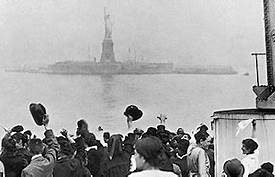 America has been the land of opportunity since its inception, and people often worked years to save enough money to pay for passage to what many considered the promised land. It wasn’t cheap, but the money for passage was just the beginning of the grueling process of becoming a citizen of the United States. They knew some of what they would face, but not all. Still, it did not deter them. For a chance at a better life, they came. Many immigrants came through Ellis Island, passing by the Statue of Liberty on their way. It was their first glimpse of what they considered the symbol of America. Then they went on to Ellis Island, where their pre-entry screening began.
America has been the land of opportunity since its inception, and people often worked years to save enough money to pay for passage to what many considered the promised land. It wasn’t cheap, but the money for passage was just the beginning of the grueling process of becoming a citizen of the United States. They knew some of what they would face, but not all. Still, it did not deter them. For a chance at a better life, they came. Many immigrants came through Ellis Island, passing by the Statue of Liberty on their way. It was their first glimpse of what they considered the symbol of America. Then they went on to Ellis Island, where their pre-entry screening began.
First, they were rigorously questioned…what we call vetting today. They asked things like: “Are you meeting a relative here in America? Who? Have you been in a prison, almshouse, or institution for care of the insane? Are you a polygamist? Are you an anarchist? Are you coming to America for a job? Where will you work? Are you  deformed or crippled? Who was the first President of America? What is the Constitution? Which President freed the slaves? Can you name the 13 original Colonies? Who is the current President of the United States?” Providing they passed this first test, they moved on to the next level. Many people these days would take offense at some of these questions…especially the health questions. What they don’t understand is that an unhealthy person or one with a disability could have been a burden to society…even more so than the problems with disabilities today. I know that sounds bad, but they couldn’t afford to take lots of people that the government was going to have to support. They also couldn’t take people with a communicable disease that could cause an epidemic in our country…something we can all understand these days. Every immigrant with a medical condition was marked on their on the shoulder of their clothing with their condition. Things like “PG” for pregnant, “B” for back problems, “SC” for scalp condition, etc. That way, every station down the line knew the problem. Sick children had to be quarantined away from their parents.
deformed or crippled? Who was the first President of America? What is the Constitution? Which President freed the slaves? Can you name the 13 original Colonies? Who is the current President of the United States?” Providing they passed this first test, they moved on to the next level. Many people these days would take offense at some of these questions…especially the health questions. What they don’t understand is that an unhealthy person or one with a disability could have been a burden to society…even more so than the problems with disabilities today. I know that sounds bad, but they couldn’t afford to take lots of people that the government was going to have to support. They also couldn’t take people with a communicable disease that could cause an epidemic in our country…something we can all understand these days. Every immigrant with a medical condition was marked on their on the shoulder of their clothing with their condition. Things like “PG” for pregnant, “B” for back problems, “SC” for scalp condition, etc. That way, every station down the line knew the problem. Sick children had to be quarantined away from their parents.
Sometimes people had to be held at Ellis Island for a time…weeks and even months, until they got well, or could get someone who would agree to sponsor them with their disabilities. That said, another problem or set of problems occurred. There were minimal beds available at any given time, and people spoke different languages, making communication difficult. Often, fights broke out and had to be settled, and sometimes 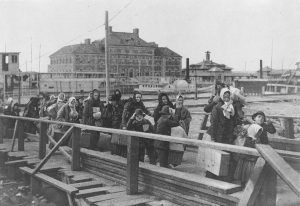 people had to sleep on the floor. Sometimes, children came over alone. Their parents were dead, and they were sent to live with relatives or maybe to be adopted. Sometimes they were on Ellis Island for months…so long in fact that a playground was build so they could play. A school was started because they needed an education. And sometimes children had to be sent back alone or with a parent if they had one. Some people were rejected. It was part of the process. It was hard…on everyone, but the reward was a better life, if they were accepted. It was tough, and still, they came. They knew it was worth it. The nation has always accepted immigrants. We just expect them to do so legally. The process is difficult, but it is worth it.
people had to sleep on the floor. Sometimes, children came over alone. Their parents were dead, and they were sent to live with relatives or maybe to be adopted. Sometimes they were on Ellis Island for months…so long in fact that a playground was build so they could play. A school was started because they needed an education. And sometimes children had to be sent back alone or with a parent if they had one. Some people were rejected. It was part of the process. It was hard…on everyone, but the reward was a better life, if they were accepted. It was tough, and still, they came. They knew it was worth it. The nation has always accepted immigrants. We just expect them to do so legally. The process is difficult, but it is worth it.
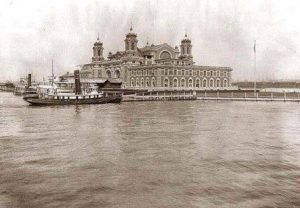 A number of my ancestors came to America during and prior to the years that Ellis Island was the processing center in New York. I have no doubt that some of them came through Ellis Island, but I have not confirmed that. I find many of the names in my tree, but while many of the ancestors I have found came over by way of New York, it would appear that my direct line arrived in America before the immigration center at Ellis Island opened on January 2, 1892. Before that time, immigrants were handled by the individual states where the immigrant first arrived. It is estimated that about 40% of Americans can trace their roots through Ellis Island, so while I see many familiar names, they may or may not be my direct line, and in fact, they might not be related at all.
A number of my ancestors came to America during and prior to the years that Ellis Island was the processing center in New York. I have no doubt that some of them came through Ellis Island, but I have not confirmed that. I find many of the names in my tree, but while many of the ancestors I have found came over by way of New York, it would appear that my direct line arrived in America before the immigration center at Ellis Island opened on January 2, 1892. Before that time, immigrants were handled by the individual states where the immigrant first arrived. It is estimated that about 40% of Americans can trace their roots through Ellis Island, so while I see many familiar names, they may or may not be my direct line, and in fact, they might not be related at all.
Ellis Island is located in New York Harbor off the New Jersey coast and was named for merchant Samuel Ellis, who owned the land in the 1770s. The island was given the nickname, The Gateway to America because more than 12 million immigrants passed through the center since it opened in 1892. On January 2, 1892, 15 year old Annie Moore, from Ireland, became the first person to pass through the newly opened Ellis Island, which President Benjamin Harrison designated as America’s first federal immigration center in 1890. Oddly, not all 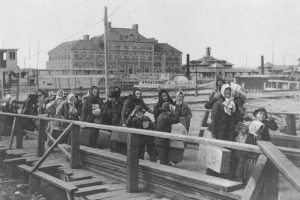 immigrants who sailed into New York had to go through Ellis Island. First and second class passengers were just given a brief shipboard inspection and then disembarked at the piers in New York or New Jersey, where they passed through customs. People in third class, though, were transported to Ellis Island, where they underwent medical and legal inspections to ensure they didn’t have a contagious disease or some condition that would make them a burden to the government. Nevertheless, only two percent of all immigrants were denied entrance into the United States. The peak years of immigration through Ellis Island were from 1892 to 1924. The 3.3 acre island was enlarged by landfill, and by the 1930s, it had reached its current size of 27.5 acres. After the extra size was completed, new buildings were constructed to handle the massive influx of people coming to America for a better life. During it’s busiest year, which was 1907, over 1 million people were processed through Ellis Island.
immigrants who sailed into New York had to go through Ellis Island. First and second class passengers were just given a brief shipboard inspection and then disembarked at the piers in New York or New Jersey, where they passed through customs. People in third class, though, were transported to Ellis Island, where they underwent medical and legal inspections to ensure they didn’t have a contagious disease or some condition that would make them a burden to the government. Nevertheless, only two percent of all immigrants were denied entrance into the United States. The peak years of immigration through Ellis Island were from 1892 to 1924. The 3.3 acre island was enlarged by landfill, and by the 1930s, it had reached its current size of 27.5 acres. After the extra size was completed, new buildings were constructed to handle the massive influx of people coming to America for a better life. During it’s busiest year, which was 1907, over 1 million people were processed through Ellis Island.
When the United States entered into World War I, immigration to the United States decline, most likely because travel anywhere was risky. Ellis Island was used as a detention center for suspected enemies during that time. Following the war, Congress passed quota laws and the Immigration Act of 1924, which sharply reduced the number of newcomers allowed into the country and also enabled immigrants to be processed at United States 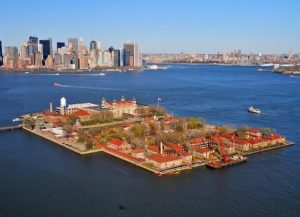 consulates abroad. The act also enabled immigrants to be processed at United States consulates abroad, making detention at Ellis Island obsolete. After 1924, Ellis Island switched from a processing center to other purposes, such as a detention and deportation center for illegal immigrants, a hospital for wounded soldiers during World War II and a Coast Guard training center. In November 1954, the last detainee, a Norwegian merchant seaman, was released and Ellis Island officially closed on November 12, 1954. In 1984, Ellis Island underwent a $160 million renovation, the largest historic restoration project in United States history. In September 1990, the Ellis Island Immigration Museum opened to the public and is visited by almost 2 million people each year.
consulates abroad. The act also enabled immigrants to be processed at United States consulates abroad, making detention at Ellis Island obsolete. After 1924, Ellis Island switched from a processing center to other purposes, such as a detention and deportation center for illegal immigrants, a hospital for wounded soldiers during World War II and a Coast Guard training center. In November 1954, the last detainee, a Norwegian merchant seaman, was released and Ellis Island officially closed on November 12, 1954. In 1984, Ellis Island underwent a $160 million renovation, the largest historic restoration project in United States history. In September 1990, the Ellis Island Immigration Museum opened to the public and is visited by almost 2 million people each year.
 On June 17, 1885…129 years ago today, the Statue of Liberty, in a dismantled form, arrived in New York Harbor. It was a gift from France to commemorate our friendship with them during the American Revolution. While the Statue of Liberty would not be officially assembled and dedicated until October 8th, 1886, this was it’s official arrival. The Statue of Liberty’s 300 copper pieces packed in 214 crates were transported on the French ship “Isere” to America. Although the ship nearly sank in rough seas, it arrived in New York on June 17, 1885. The Statue’s parts remained unassembled for nearly a year until the pedestal was completed in 1886. What really shocks me is that there were only 350 parts to make up the Statue of Liberty. That seems impossible. Having been to, and inside the Statue of Liberty, I know how big it is. I would have guessed more like 1000 pieces. Today Lady Liberty has become known around the world as an enduring symbol of freedom and democracy.
On June 17, 1885…129 years ago today, the Statue of Liberty, in a dismantled form, arrived in New York Harbor. It was a gift from France to commemorate our friendship with them during the American Revolution. While the Statue of Liberty would not be officially assembled and dedicated until October 8th, 1886, this was it’s official arrival. The Statue of Liberty’s 300 copper pieces packed in 214 crates were transported on the French ship “Isere” to America. Although the ship nearly sank in rough seas, it arrived in New York on June 17, 1885. The Statue’s parts remained unassembled for nearly a year until the pedestal was completed in 1886. What really shocks me is that there were only 350 parts to make up the Statue of Liberty. That seems impossible. Having been to, and inside the Statue of Liberty, I know how big it is. I would have guessed more like 1000 pieces. Today Lady Liberty has become known around the world as an enduring symbol of freedom and democracy.
Having been to the Statue of Liberty, I find it very interesting to think that it arrived here 129 years ago today. I don’t know how many of you have been inside the statue, or how far up you were able to go, but I have been to the crown. I was very disappointed that we could not go to the torch, but for safety reasons, the torch has been closed to visitors since 1916, after an incident called the Black Tom explosions in which munitions-laden barges and railroad cars on the Jersey City, New Jersey, waterfront were blown up by German agents, causing damage to the nearby statue. That was something I didn’t know, and sadly there was nothing that would change it, but I was inside the Statue of Liberty, and it was so amazing…like a dream, not a reality!! I know that lots of people have been there and lots have been inside, and lots have even been to the crown, but I had not…and then I had…and, it was surreal!!
When I think about all the people who have sailed past this statue as they came to their new  home…and how many of them were my ancestors or Bob’s ancestors, it is just mind boggling. If she could talk…what stories could she tell. The Statue of Liberty has seen so much. Ships have come and gone, immigrants have arrived, the city has changed…and been attacked. What stories she could tell of happiness, sadness, floods, hurricanes, and terrorism. She has seen the transformation of her near neighbor from the location of Fort Gibson, to the current site of the Ellis Island Immigrant Station. She watched the planes fly into the World Trade Center…and their fall. When I think about all the changes that have taken place in our nation since Lady Liberty arrived, I wish she could speak, because the stories she could tell of our nation’s history would be amazing.
home…and how many of them were my ancestors or Bob’s ancestors, it is just mind boggling. If she could talk…what stories could she tell. The Statue of Liberty has seen so much. Ships have come and gone, immigrants have arrived, the city has changed…and been attacked. What stories she could tell of happiness, sadness, floods, hurricanes, and terrorism. She has seen the transformation of her near neighbor from the location of Fort Gibson, to the current site of the Ellis Island Immigrant Station. She watched the planes fly into the World Trade Center…and their fall. When I think about all the changes that have taken place in our nation since Lady Liberty arrived, I wish she could speak, because the stories she could tell of our nation’s history would be amazing.

